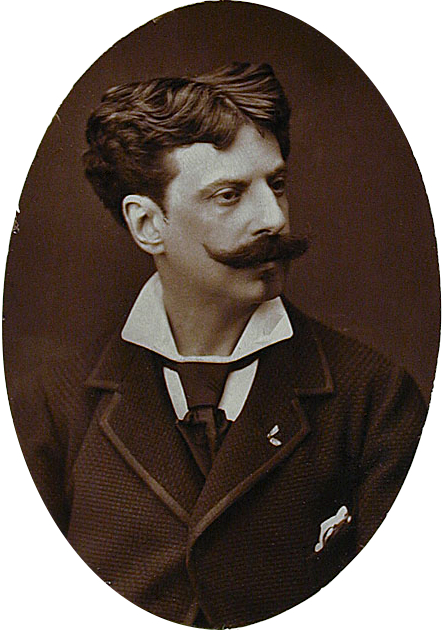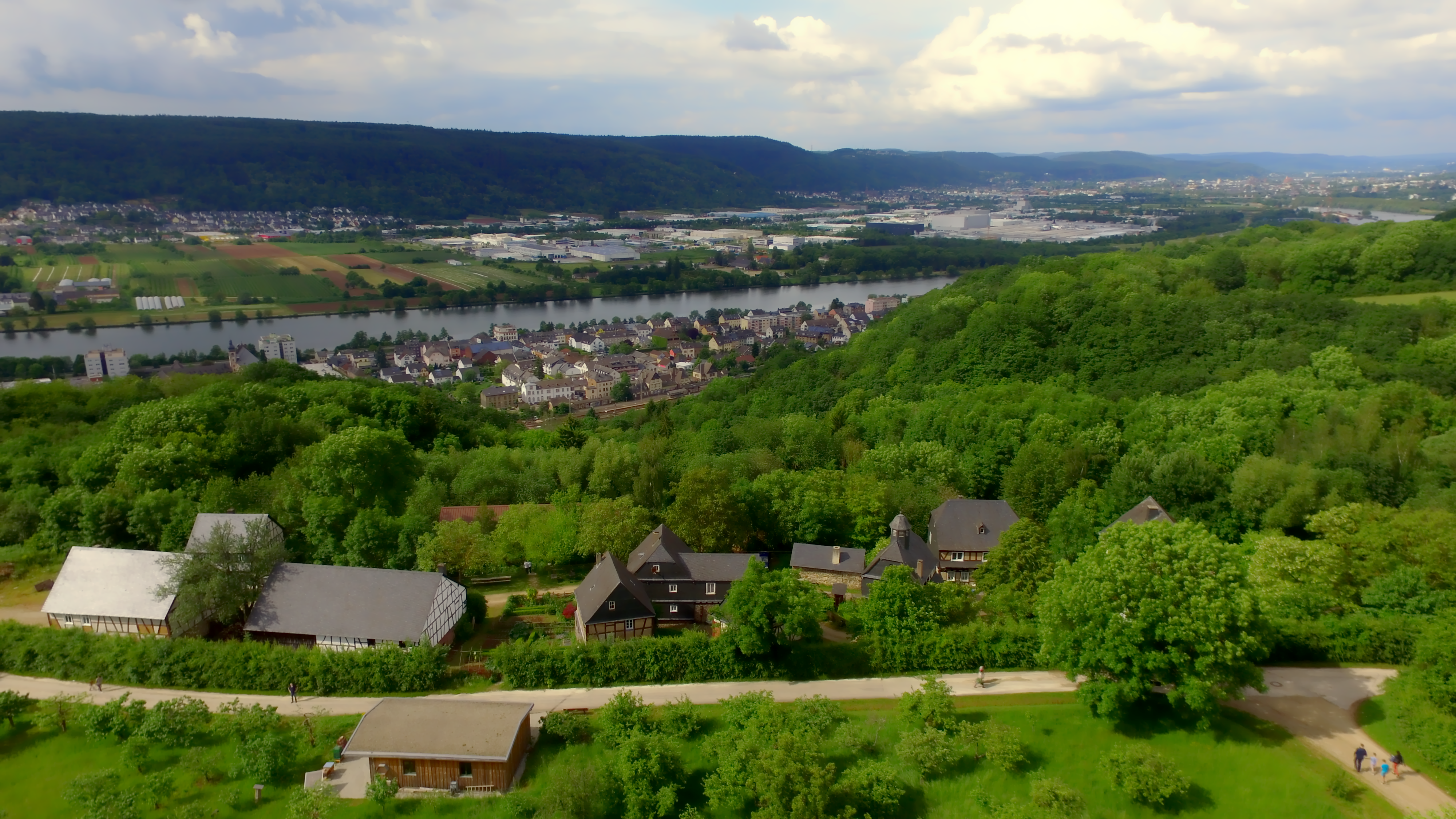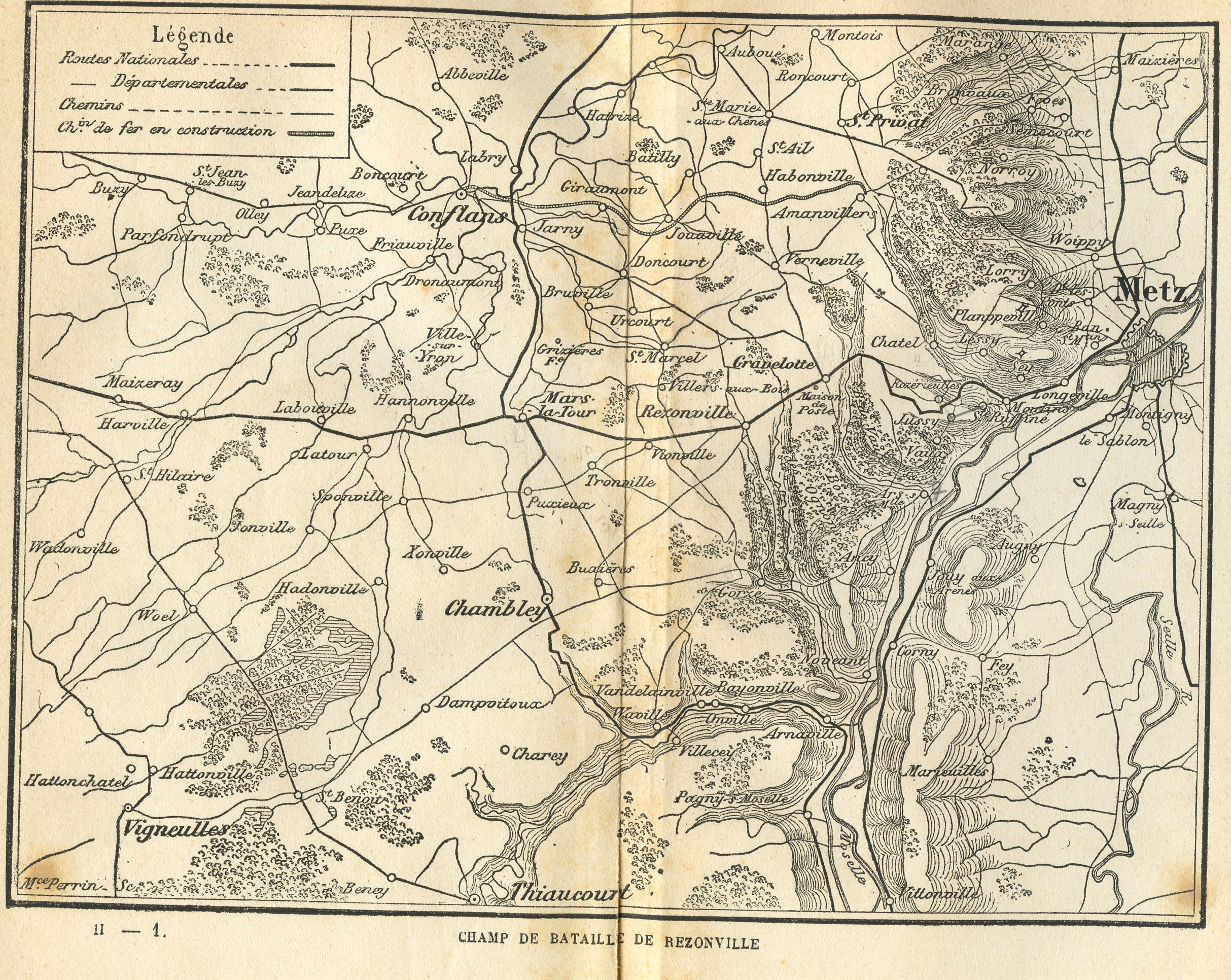|
Battle Of Gravelotte
The Battle of Gravelotte (or Battle of Gravelotte–St. Privat) on 18 August 1870 was the largest battle of the Franco-Prussian War. Named after Gravelotte, a village in Lorraine, it was fought about west of Metz, where on the previous day, having intercepted the French army's retreat to the west at the Battle of Mars-la-Tour, the Prussians were now closing in to complete the destruction of the French forces. The combined German forces under King Wilhelm I were the Prussian First and Second Armies of the North German Confederation with 210 infantry battalions, 133 cavalry squadrons, and 732 heavy cannons totaling 188,332 officers and men. The French Army of the Rhine, commanded by Marshal François Achille Bazaine, dug in along high ground with their southern left flank at the town of Rozerieulles, and their northern right flank at St. Privat. On 18 August, the Prussian First Army under General Karl Friedrich von Steinmetz launched its VII and VIII Corps in repeated assaults a ... [...More Info...] [...Related Items...] OR: [Wikipedia] [Google] [Baidu] |
Alphonse-Marie-Adolphe De Neuville
Alphonse-Marie-Adolphe de Neuville (31 May 183518 May 1885) was a French academic painter who studied under Eugène Delacroix. His dramatic and intensely patriotic subjects illustrated episodes from the Franco-Prussian War, the Crimean War, the Zulu War, and portraits of soldiers. Some of his works have been collected by the Hermitage Museum in St. Petersburg and by the Metropolitan Museum in New York. Early life Born Alphonse-Marie-Adolphe Deneuville to wealthy parents at Saint-Omer, Pas-de-Calais, he earned his degree of ''bachelier ès-lettres'', and in 1856 entered the naval school at Lorient in spite of family opposition. It was there that his artistic instincts started. The young Alphonse de Neuville was discouraged by several painters of repute, but he was admitted to work in the studio of François-Edouard Picot. He did not remain there long. He was already painting by himself when he produced his first picture, ''The Fifth Battalion of Chasseurs at the Gervais Batt ... [...More Info...] [...Related Items...] OR: [Wikipedia] [Google] [Baidu] |
VII Corps (German Empire)
The VII Army Corps / VII AK (german: VII. Armee-Korps) was a corps level command of the Prussian and then the Imperial German Armies from the 19th Century to World War I. Originating in 1815 as the General Command for the Province of Westphalia, the headquarters was in Münster and its catchment area was the Province of Westphalia and the Principalities of Lippe and Schaumburg-Lippe. The Corps served in the Austro-Prussian War. During the Franco-Prussian War it was assigned to the 1st Army. In peacetime the Corps was assigned to the III Army Inspectorate which became the 2nd Army at the start of the First World War. It was still in existence at the end of the war in the 7th Army, ''Heeresgruppe Deutscher Kronprinz'' on the Western Front. The Corps was disbanded with the demobilisation of the German Army after World War I. Austro-Prussian War VII Corps fought in the Austro-Prussian War in 1866, seeing action in the Battle of Königgrätz. Franco-Prussian War During th ... [...More Info...] [...Related Items...] OR: [Wikipedia] [Google] [Baidu] |
Roncourt
Roncourt (; ) is a commune in the Moselle department in Grand Est in north-eastern France. See also * Communes of the Moselle department The following is a list of the 725 Communes of France, communes of the Moselle (department), Moselle Departments of France, department of France. The communes cooperate in the following Communes of France#Intercommunality, intercommunalities (as ... References External links * Communes of Moselle (department) {{Metz-geo-stub ... [...More Info...] [...Related Items...] OR: [Wikipedia] [Google] [Baidu] |
Metz
Metz ( , , lat, Divodurum Mediomatricorum, then ) is a city in northeast France located at the confluence of the Moselle and the Seille rivers. Metz is the prefecture of the Moselle department and the seat of the parliament of the Grand Est region. Located near the tripoint along the junction of France, Germany and Luxembourg,Says J.M. (2010) La Moselle, une rivière européenne. Eds. Serpenoise. the city forms a central place of the European Greater Region and the SaarLorLux euroregion. Metz has a rich 3,000-year history,Bour R. (2007) Histoire de Metz, nouvelle édition. Eds. Serpenoise. having variously been a Celtic ''oppidum'', an important Gallo-Roman city,Vigneron B. (1986) Metz antique: Divodurum Mediomatricorum. Eds. Maisonneuve. the Merovingian capital of Austrasia,Huguenin A. (2011) Histoire du royaume mérovingien d'Austrasie. Eds. des Paraiges. pp. 134,275 the birthplace of the Carolingian dynasty,Settipani C. (1989) Les ancêtres de Charlemagne. Ed. ... [...More Info...] [...Related Items...] OR: [Wikipedia] [Google] [Baidu] |
Moselle River
The Moselle ( , ; german: Mosel ; lb, Musel ) is a river A river is a natural flowing watercourse, usually freshwater, flowing towards an ocean, sea, lake or another river. In some cases, a river flows into the ground and becomes dry at the end of its course without reaching another body of wate ... that rises in the Vosges mountains and flows through north-eastern France and Luxembourg to western Germany. It is a bank (geography), left bank tributary of the Rhine, which it joins at Koblenz. A small part of Belgium is in its drainage basin, basin as it includes the Sauer and the Our River, Our. Its lower course "twists and turns its way between Trier and Koblenz along one of Germany's most beautiful river valleys."''Moselle: Holidays in one of Germany's most beautiful rive ... [...More Info...] [...Related Items...] OR: [Wikipedia] [Google] [Baidu] |
Moselle
The Moselle ( , ; german: Mosel ; lb, Musel ) is a river that rises in the Vosges mountains and flows through north-eastern France and Luxembourg to western Germany. It is a bank (geography), left bank tributary of the Rhine, which it joins at Koblenz. A small part of Belgium is in its drainage basin, basin as it includes the Sauer and the Our River, Our. Its lower course "twists and turns its way between Trier and Koblenz along one of Germany's most beautiful river valleys."''Moselle: Holidays in one of Germany's most beautiful river valleys'' at www.romantic-germany.info. Retrieved 23 Jan 2016. In this section the land to the north is the Eifel which stretches into Belgium; to the south lies the Hunsrück. The river flows through a region that was cultivated by the Ro ... [...More Info...] [...Related Items...] OR: [Wikipedia] [Google] [Baidu] |
Bazaine
Bazaine is a surname. Notable people with the surname include: * Adolphe Bazaine-Vasseur (1809–1893), French railway engineer * François Achille Bazaine (1811–1888), French military officer * George Albert Bazaine-Hayter (1843–1914), French military officer * Jean René Bazaine Jean René Bazaine (21 December 1904 – 4 March 2001) was a French painter, designer of stained glass windows and writer. He was the great great grandson of the English Court portraitist Sir George Hayter. Studies Bazaine was born in Paris. He ... (1904–2001), French painter, designer of stained glass windows, and writer * Pierre-Dominique Bazaine (1786–1838), French mathematician and military engineer {{surname French-language surnames ... [...More Info...] [...Related Items...] OR: [Wikipedia] [Google] [Baidu] |
Battle Of Mars-La-Tour
The Battle of Mars-la-Tour (also known as the Battle of Vionville or Battle of Rezonville) was fought on 16 August 1870, during the Franco-Prussian War, near the village of Mars-La-Tour in northeast France. One Prussian corps, reinforced by two more later in the day, encountered the entire French Army of the Rhine in a meeting engagement and, surprisingly, forced the Army of the Rhine to retreat toward the fortress of Metz. A cavalry patrol of the 1st Squadron of the 1st Hanoverian Dragoon Regiment No. 9, led by Rittmeister Oskar von Blumenthal, discovered that Marshal François Bazaine's 160,000-man Army of the Rhine was attempting to escape from Metz to join with French forces at Verdun. This intelligence prompted General Prince Friedrich Karl, commander of the Prussian Second Army, to order at 1900 on 15 August a grossly outnumbered group of 30,000 men of the advanced III Corps under General Constantin von Alvensleben to cut off the French line of retreat at Mars-la-Tour ... [...More Info...] [...Related Items...] OR: [Wikipedia] [Google] [Baidu] |
Prince Friedrich Karl Of Prussia (1828–1885)
Prince Friedrich Karl Nikolaus of Prussia (20 March 1828 – 15 June 1885) was the son of Prince Charles of Prussia (1801–1883) and his wife, Princess Marie of Saxe-Weimar-Eisenach (1808–1877). Prince Friedrich Karl was a grandson of King Frederick William III of Prussia and a nephew of Frederick William IV and William I. As a military commander, the Prince had a major influence on the Royal Prussian Army's advances in training and tactics in the 1850s and 1860s. He commanded one of the armies which defeated the Austrian army at the Battle of Königgrätz in 1866 and the French Army of the Rhine at the Battle of Mars-la-Tour, overseeing the defeat of the Army of the Rhine at the Siege of Metz in 1870. Biography Friedrich Karl was born at the Royal Palace in Berlin on 20 March 1828, as the only son of Prince Charles of Prussia, the brother of future German emperor William I. From 1842 to 1846, Frederick Charles was under the military tutelage of then Major Albrecht von R ... [...More Info...] [...Related Items...] OR: [Wikipedia] [Google] [Baidu] |
Siege Of Metz (1870)
The siege of Metz was a battle fought during the Franco-Prussian War from August 19 to October 27, 1870 and ended in a decisive Allied German victory. The French Army of the Rhine under François Bazaine retreated into the Metz fortress after its defeat by the Germans at the Battle of Gravelotte on 18 August 1870. The fortress was promptly surrounded by German forces under Prince Friedrich Karl of Prussia. The French Army of Châlons was sent to relieve the Army of the Rhine but was itself encircled and annihilated by the German armies at the Battle of Sedan on 1–2 September. Unable to capture the fortress by bombardment or storm, the besieging Germans resorted to starving the French to submission. French attempts to break out ended in defeat at the battles of Noisseville on 31 August – 1 September and Bellevue on 7 October. French food supplies ran out on 20 October and François Achille Bazaine surrendered the fortress and the entire Army of the Rhine, some 193,000 ... [...More Info...] [...Related Items...] OR: [Wikipedia] [Google] [Baidu] |
Verdun
Verdun (, , , ; official name before 1970 ''Verdun-sur-Meuse'') is a large city in the Meuse department in Grand Est, northeastern France. It is an arrondissement of the department. Verdun is the biggest city in Meuse, although the capital of the department is Bar-le-Duc, which is slightly smaller than Verdun. It is well known for giving its name to a major battle of the First World War. Geography Verdun is situated on both banks of the river Meuse, in the northern part of the Meuse department. It is connected by rail to Jarny. The A4 autoroute Paris–Metz–Strasbourg passes south of the town. History Verdun (''Verodunum'', a latinisation of a place name meaning "strong fort" in Gaulish) was founded by the Gauls. It has been the seat of the bishop of Verdun since the 4th century, with interruptions.A History of Food, Maguelonne Toussaint-Samat, Blackwell Publishing 1992, p.567 In 486, following the decisive Frankish victory at the Battle of Soissons, the city (amon ... [...More Info...] [...Related Items...] OR: [Wikipedia] [Google] [Baidu] |
XII (1st Royal Saxon) Corps
The XII (1st Royal Saxon) Army Corps / XII AK (german: XII. (I. Königlich Sächsisches) Armee-Korps) was a Saxon corps level command of the Saxon and German Armies before and during World War I. The Corps was formed as the Royal Saxon Corps on 1 April 1867 and headquartered in Dresden. Initially, it commanded the 1st Royal Saxon Infantry Division in Dresden and the 2nd Royal Saxon Infantry Division in Leipzig. After the XIX (2nd Royal Saxon) Corps was set up on 1 April 1899 as the headquarters for the western part of the Kingdom of Saxony, XII Corps was made responsible for the eastern part of the Kingdom. The Corps was disbanded with the demobilisation of the German Army after World War I. Franco-Prussian War During the Franco-Prussian War, the corps fought in the Battle of Gravelotte, the Battle of Sedan and the Siege of Paris. Order of Battle during the Franco-Prussian War The organization of the XII (Royal Saxon) Corps on 18 August 1870 at the beginning of the Fra ... [...More Info...] [...Related Items...] OR: [Wikipedia] [Google] [Baidu] |








